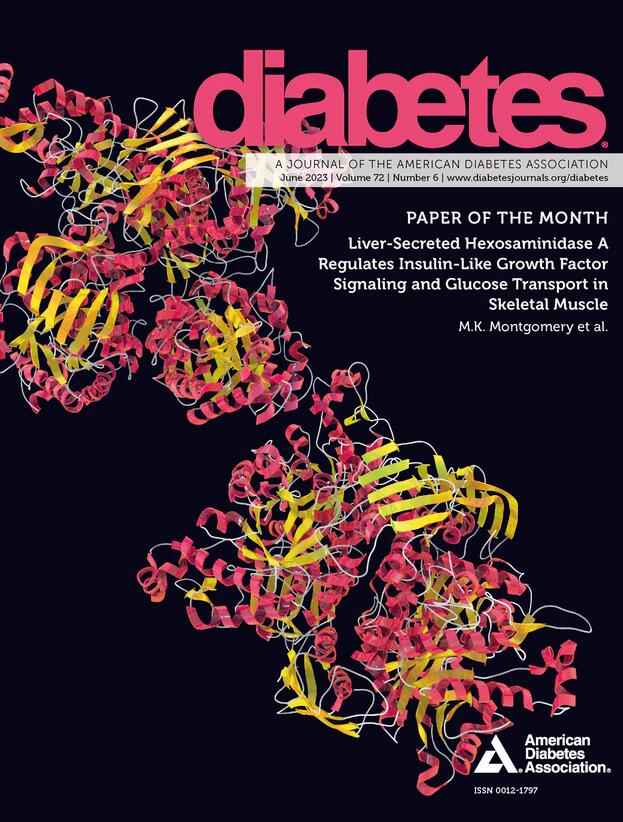2078-LB: Prenatal Exposure to Maternal Obesity or Gestational Diabetes Is Associated with Gut Hormone Dysregulation in Children
IF 7.5
1区 医学
Q1 ENDOCRINOLOGY & METABOLISM
引用次数: 0
Abstract
Introduction and Objective: Children of mothers with obesity or gestational diabetes mellitus (GDM) face increased metabolic risk, yet mechanisms remain unclear. The gut hormones, GLP-1 and ghrelin, regulate appetite and glucose metabolism. GLP-1 enhances insulin secretion and satiety, while ghrelin stimulates hunger. We investigated whether exposure to maternal obesity or GDM is associated with alterations in GLP-1 and ghrelin responses to oral glucose. Methods: The analysis included 19 children (68% female; 12 GDM-exposed, 7 unexposed) aged 7-14 years from the BrainChild Study. Maternal pre-pregnancy BMI and GDM status were extracted from electronic medical records. Stored plasma samples were assayed for gut hormones collected after a 12-hour fast and 30-min post-oral glucose load (1.75 g/kg body weight). A multiplex immunoassay (MilliporeSigma) quantified active ghrelin and GLP-1. Spearman correlations assessed associations between maternal pre-pregnancy BMI and child hormone levels, and independent t-tests compared hormone responses between GDM-exposed and unexposed children, before and after adjusting for child age and sex. Results: Compared to unexposed children, GDM-exposed children had smaller post-glucose increases in GLP-1 levels (unadjusted: 29.07 vs. 17.87 pg/ml, p=0.17; adjusted: 29.13 vs. 17.95 pg/ml p=0.20) and less ghrelin suppression (unadjusted: -99.68 vs. -34.49 pg/ml, p=0.05; adjusted: -101.31 vs -43.19 pg/ml, p=0.08), respectively. Maternal pre-pregnancy BMI correlated with lower child GLP-1 secretion (unadjusted: ρ =-0.30, p=0.21; adjusted: ρ =-0.25, p=0.33) and less ghrelin suppression (unadjusted: ρ =0.55, p=0.01; adjusted: ρ =0.52, p=0.03). Conclusion: These preliminary findings suggest that prenatal exposure to maternal GDM or obesity is associated with altered GLP-1 and ghrelin responses to oral glucose. Further research is needed to elucidate how these changes contribute to metabolic risk in children. Disclosure E.C. Morgan: None. J.M. Alves: None. T. Chow: None. A. Xiang: None. K.A. Page: None. Funding American Diabetes Association (1-14-ACE-36); NIH (RO1DK134079), (RO1DK116858)2078-LB:产前暴露于母亲肥胖或妊娠糖尿病与儿童肠道激素失调有关
前言和目的:母亲患有肥胖症或妊娠期糖尿病(GDM)的儿童代谢风险增加,但机制尚不清楚。肠道激素GLP-1和胃饥饿素调节食欲和葡萄糖代谢。GLP-1促进胰岛素分泌和饱腹感,而ghrelin刺激饥饿感。我们研究了暴露于母亲肥胖或GDM是否与GLP-1和胃饥饿素对口服葡萄糖的反应改变有关。方法:分析19例儿童(68%为女性;12名gdm暴露者,7名未暴露者)来自BrainChild研究的7-14岁儿童。从电子病历中提取孕妇孕前BMI和GDM状态。在禁食12小时和口服葡萄糖负荷(1.75 g/kg体重)30分钟后,检测储存的血浆样本中收集的肠道激素。多重免疫分析法(MilliporeSigma)定量了活性胃饥饿素和GLP-1。Spearman相关性评估了母亲孕前BMI和儿童激素水平之间的关系,独立t检验比较了gdm暴露和未暴露儿童在调整儿童年龄和性别之前和之后的激素反应。结果:与未暴露的儿童相比,gdm暴露的儿童葡萄糖后GLP-1水平升高较小(未经调整:29.07 vs. 17.87 pg/ml, p=0.17;调整后:29.13 vs. 17.95 pg/ml p=0.20)和较少的生长素抑制(未调整:-99.68 vs. -34.49 pg/ml, p=0.05;调整后:-101.31 vs -43.19 pg/ml, p=0.08)。孕妇孕前BMI与儿童GLP-1分泌降低相关(未经调整:ρ =-0.30, p=0.21;调整后:ρ =-0.25, p=0.33)和较少的生长素抑制(未调整:ρ =0.55, p=0.01;校正:ρ =0.52, p=0.03)。结论:这些初步研究结果表明,产前暴露于母体GDM或肥胖与GLP-1和ghrelin对口服葡萄糖的反应改变有关。需要进一步的研究来阐明这些变化是如何导致儿童代谢风险的。摩根:没有。J.M.阿尔维斯:没有。周星驰:没有。A. Xiang:没有。佩奇:没有。资助美国糖尿病协会(1-14 ace -36);Nih (ro1dk134079), (ro1dk116858)
本文章由计算机程序翻译,如有差异,请以英文原文为准。
求助全文
约1分钟内获得全文
求助全文
来源期刊

Diabetes
医学-内分泌学与代谢
CiteScore
12.50
自引率
2.60%
发文量
1968
审稿时长
1 months
期刊介绍:
Diabetes is a scientific journal that publishes original research exploring the physiological and pathophysiological aspects of diabetes mellitus. We encourage submissions of manuscripts pertaining to laboratory, animal, or human research, covering a wide range of topics. Our primary focus is on investigative reports investigating various aspects such as the development and progression of diabetes, along with its associated complications. We also welcome studies delving into normal and pathological pancreatic islet function and intermediary metabolism, as well as exploring the mechanisms of drug and hormone action from a pharmacological perspective. Additionally, we encourage submissions that delve into the biochemical and molecular aspects of both normal and abnormal biological processes.
However, it is important to note that we do not publish studies relating to diabetes education or the application of accepted therapeutic and diagnostic approaches to patients with diabetes mellitus. Our aim is to provide a platform for research that contributes to advancing our understanding of the underlying mechanisms and processes of diabetes.
 求助内容:
求助内容: 应助结果提醒方式:
应助结果提醒方式:


